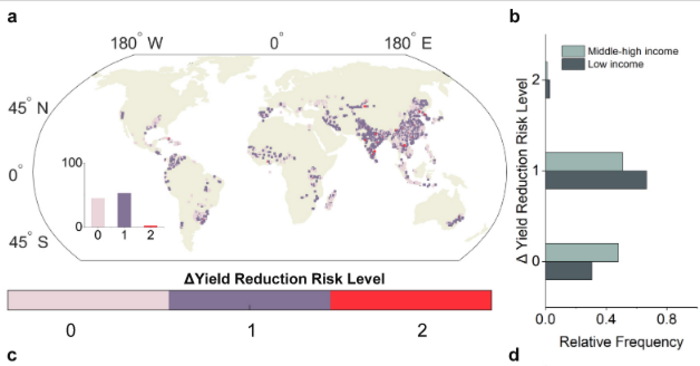The high concentration of carbon dioxide (CO2) in the atmosphere is a double-edged sword, because it has an impact on global food security and climate emergency. According to the conclusion of an international research team involving CREAF, a high concentration of CO2 in the atmosphere reduces by more than 20% the availability of phosphorus in soils where rice is grown, an essential fertiliser mineral for a productive soil. This result is part of two unique long-term experiments in which, for the first time, rice fields have been studied under conditions of high carbon dioxide. The article Reduced phosphorus availability in paddy soils under atmospheric CO2 enrichment has been published in the journal Nature Geoscience and involved experts from Australia, Spain, Canada, USA, France and China.

Credit: CREAF
The high concentration of carbon dioxide (CO2) in the atmosphere is a double-edged sword, because it has an impact on global food security and climate emergency. According to the conclusion of an international research team involving CREAF, a high concentration of CO2 in the atmosphere reduces by more than 20% the availability of phosphorus in soils where rice is grown, an essential fertiliser mineral for a productive soil. This result is part of two unique long-term experiments in which, for the first time, rice fields have been studied under conditions of high carbon dioxide. The article Reduced phosphorus availability in paddy soils under atmospheric CO2 enrichment has been published in the journal Nature Geoscience and involved experts from Australia, Spain, Canada, USA, France and China.
The article projects a great risk of rice yield reduction, especially in low-income countries, a situation that places them in adverse conditions and further widens economic inequality due to CO2 emissions and impacts on geochemical processes. The conclusions show that 55% of large rice paddy fields in China and India will experience increased risk of yield reduction due to phosphorus deficiency. In relative terms, low-income countries (apart from China and India, especially those located in South East Asia, Central America, South America, Africa and the Middle East) will experience more critical situations, with 70% of paddy fields expected to suffer higher yield reduction risks, compared to 52% in middle and high-income countries.
The work has revealed a contradiction: while atmospheric CO2 is the main source of carbon for crops, its high concentration in the atmosphere limits the presence of phosphorus fertilizer in the soil in the long term. This mineral is essential for the metabolism and growth of plants in agricultural soils. According to CREAF and CSIC researcher Josep Peñuelas, “when there is a high concentration of CO2 in the atmosphere, plants enjoy this fertilising effect in the short term, but in the long term, rice crops no longer have available phosphorus and the soil is impoverished, so plant growth is compromised”.
As a consequence, this compromises food security in a context of global population growth where rice plays a major role.
A global challenge
Phosphorus chemical fertiliser is unevenly distributed around the world and is made from rock phosphate, a non-renewable resource. A 70% of its reserves are found in Morocco and Western Sahara, and many countries depend on imports for its availability. Sustained deficits can therefore lead to limited agricultural yields in certain regions of the world. Moreover, this situation may worsen in the future as atmospheric CO2 levels continue to rise, limiting the presence of phosphorus.
The situation poses an international socio-political challenge in terms of access to this mineral with fertiliser capacity. “The difficulty of countries with less purchasing power to fertilise their farmland with phosphorus supplements is evident and worrying,” says researcher Josep Peñuelas. Indeed, during the world food crisis of 2007-2008, the price for phosphate rock and fertilisers increased by 400% in 14 months, indicative of the strong socio-economic instability associated with phosphorus. This price increase has also occurred in 2022.
As an alternative, the scientific team argues that there is an urgent need to plan international phosphorus management strategies that take into account future global changes.
Compensation, a contested alternative
Fertilising agricultural soils seems to be the best way to offset phosphorus reductions caused by atmospheric carbon dioxide in the long term, but it has consequences that need to be avoided. On the one hand, over-fertilisation of arable soil with phosphorus to maximise yields accumulates this mineral in affluent countries that can afford it, mainly in Europe, North America and some in Southeast Asia. And, on the other hand, phosphorus accumulated in the soil is lost through rainwater runoff, erosion and leaching (the loss of water-soluble nutrients). In addition, excessive presence of phosphorus in river and marine waters is the main cause of harmful algal blooms, fish kills in estuaries and coastal waters, and the generation of dead zones, a situation known to science as eutrophication.
For the first time, two scientific experiments have been carried out over 15 and 9 years with rice. FACE (Free Air CO2 Enrichment) technology has been applied, the most widely used in science to raise the concentration of atmospheric carbon dioxide and examine the responses of the biosphere. FACE is neither cheap nor easy to maintain, so experiments that apply it for a decade are rare and highly unique around the world.
Journal
Nature Geoscience
DOI
10.1038/s41561-022-01105-y




